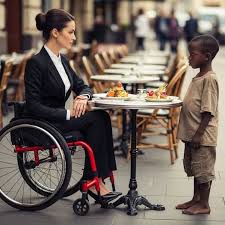Victoria Whitmore was used to people fearing her name. Eight years in a wheelchair had only sharpened her arrogance. Across the street from her mansion lived twelve-year-old Daniel Thompson and his grandmother in a crumbling apartment complex. To her, he was invisible; to him, she was a challenge.
Daniel had observed her for weeks. He saw servants carry trays of food that half ended in the trash, while he and his grandmother often went hungry. That night, it wasn’t anger that drove him to knock on her back door—it was resolve, a quiet determination to confront what no adult dared.
When Victoria wheeled into the service hallway and saw him, she sneered. “What do you want?” she asked. Daniel’s voice did not falter. “I can cure you. All I ask is for the food you throw away.” Her laugh cracked like shattering glass, disbelief mixing with amusement.
For the first time in years, Victoria hesitated. Daniel’s knowledge of her routine unnerved her. He had memorized details from across the street, guided by his grandmother Ruth’s wisdom that trauma could lock the body where iron chains never could. He simply said, “Because I see what they don’t.”
That night, Victoria’s assistant ran a background check. Daniel was a scholarship student, motherless, raised by Ruth, a retired nursing aide. No criminal record, no trouble—just a poor boy with good grades. Yet Ruth’s miraculous recovery from late-stage diabetes two years prior caught Victoria’s attention, a fact she could not dismiss.
Daniel and Ruth studied Victoria across the street. “She isn’t paralyzed the way she thinks,” he said. Ruth explained psychogenic paralysis, trauma’s invisible chains. Despite her neurologist confirming the same, Victoria fired him, unwilling to confront the truth a boy had seen.
Victoria fought back by threatening Daniel’s school, scholarship, and spreading rumors. But Ruth’s warning held: “The rich only attack the poor when they’re afraid. And she is terrified of you, child.” Daniel continued investigating, uncovering her real identity, Kowalski, and the events surrounding her husband’s death and fortune.
The final confrontation came on a Sunday morning. Daniel, Ruth, and neurologist Dr. Patricia Williams presented evidence: recordings of Victoria moving, medical files showing normal neural activity, and proof of her husband’s poisoning. Faced with the truth, Victoria obeyed Daniel’s command: she stood. Eight years of fraud collapsed in a single moment.
Months later, the mansion became the Ruth Thompson Community Center. Daniel, now a prodigy, received a full scholarship to Harvard but chose to continue his grandmother’s work. Victoria sat in a prison wheelchair, her arrogance gone. Daniel visited once, explaining, “I never wanted to destroy you. I only wanted you to stop destroying us.” Truth, patience, and courage had delivered justice.
